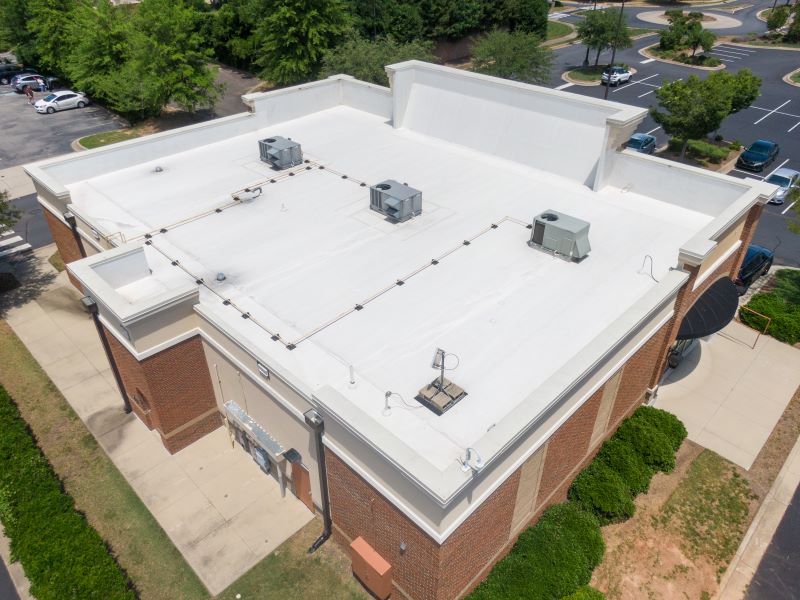Everything to Know About a Roof Installation by Geo Roofing
A new roof installation is a critical decision for homeowners in Arizona, given the city’s unique climate, which includes intense summer heat, monsoons, and occasional dust storms.
Choosing the right roofing material, understanding the installation process, and budgeting effectively can all have a major impact on the durability, energy efficiency, and long-term value of your home.
In this guide, Geo Roofing covers everything you need to know about a roof installation, from materials to the installation process, to help you make an informed decision for your roofing project.
Table of Contents
- Introduction
- Types of Flat Roofs
- Built-Up Roofing (BUR)
- Modified Bitumen Roofing
- EPDM Roofing
- TPO Roofing
- PVC Roofing
- Flat Roof Installation
- Facts About Flat Roofs
- Drainage Systems
- Flat Roof Maintenance
Get A Free Estimate On Your New Roof Today!
We Proudly Offer Flat Roof Installation Services Throughout Phoenix And The Surrounding Areas
Carefree
Cave Creek
Flagstaff
Fountain Hills
Paradise Valley
Phoenix
Scottsdale
Introduction to Flat Roofs
Flat roofs are defined by their minimal slope, typically no more than 10 degrees. While they aren’t completely flat, the slope is small enough that water runoff is managed with a drainage system. Flat roofs are often seen on modern homes, commercial buildings, and industrial properties, and are highly valued for their space-saving benefits and practicality.
In Arizona, flat roofs can be a great choice due to the region’s dry climate, where water accumulation is not as much of a concern. However, flat roofs must be designed and installed carefully to ensure that they can handle the heat and occasional rain that Arizona experiences.
Different Types of Flat Roofs
There are several types of flat roofing materials, each with its own unique benefits, lifespan, and suitability for different types of buildings. Here’s an overview of the most common types of flat roofs:
Built-Up Roofing (BUR)
Lifespan: 15-30 years
Description: Built-up roofing, often referred to as “tar and gravel” roofing, consists of multiple layers of roofing felts and bitumen (asphalt or tar), topped with a layer of gravel or crushed stone.
Benefits:
- Durable and long-lasting
- Provides excellent insulation and protection
- Offers a smooth, seamless surface
- Resistant to UV rays and weathering
Common Applications: Commercial buildings, industrial buildings, and low-slope residential homes.
Modified Bitumen Roofing
Lifespan: 20-30 years
Description: Modified bitumen is an upgraded version of BUR, featuring polymer-modified asphalt that increases the durability and flexibility of the roof. It is typically installed in multiple layers, either with heat, cold adhesive, or self-adhering membranes.
Benefits:
- Highly durable and resistant to extreme weather conditions
- Easier and faster to install than BUR
- Better flexibility, making it more suitable for buildings with some movement
Common Applications: Commercial buildings and residential homes in need of a low-maintenance roof.
EPDM Roofing
Lifespan: 25-30 years
Description: EPDM is a synthetic rubber roofing membrane known for its durability, flexibility, and weather resistance. It’s commonly available in large rolls that are either glued, mechanically fastened, or ballasted to the roof.
Benefits:
- Excellent resistance to UV rays and ozone
- Lightweight and flexible
- Highly resistant to water and weather damage
- Low maintenance and energy-efficient
Common Applications: Commercial buildings, especially those in hot climates like Arizona.
TPO Roofing
Lifespan: 20-30 years
Description: TPO is a single-ply roofing membrane made from a blend of rubber and plastic. TPO roofs are installed in large sheets and are welded together at the seams.
Benefits:
- Energy-efficient due to its reflective properties
- Resistant to UV rays, ozone, and extreme temperatures
- Quick and easy to install
Common Applications: Commercial buildings and homes with low-slope roofs.
PVC Roofing
Lifespan: 20-30 years
Description: PVC is a durable, heat-welded single-ply roofing membrane made from polyvinyl chloride. It’s commonly used in flat roof systems where durability, energy efficiency, and low maintenance are important.
Benefits:
- Resistant to chemicals, fire, and extreme weather conditions
- Energy-efficient due to its reflective surface
- Long lifespan and minimal maintenance
Common Applications: Commercial buildings and buildings located in regions with high rainfall or industrial areas.


Step-by-Step Process of Flat Roof Installation
Installing a flat roof is a detailed process that requires skill, precision, and the right materials. Here’s a breakdown of the flat roof installation process:
1. Initial Inspection and Consultation
- Our experts conduct a thorough inspection of your existing roof, evaluating its condition, structural integrity, and drainage system.
- We discuss material options with you based on your preferences, budget, and the specific requirements of your building.
2. Preparation of the Roof Deck
- The existing roof surface is cleaned and any damaged or worn-out materials are removed. This may involve removing old roofing, insulation, and debris.
- We check for signs of water damage or structural issues, such as wood rot or weakened rafters, and make necessary repairs.
3. Installing the Underlayment
- The underlayment is applied, which serves as a protective layer to prevent moisture penetration.
- The underlayment is typically a durable membrane material such as bitumen or synthetic rubber, designed to withstand Arizona’s harsh sun.
4. Applying the Roofing Membrane
- The selected roofing material (such as EPDM, TPO, or PVC) is installed, either by gluing, mechanically fastening, or heat-welding the seams to ensure a waterproof seal.
- The roofing membrane is carefully aligned to ensure no gaps or overlaps.
5. Sealing and Finishing Touches
- Flashing is applied around roof edges, vents, and other protrusions to prevent leaks.
- The roof is inspected for any flaws, and the seams are sealed for extra protection.
Geo Roofing proudly provides most major roofing brands like IB Roof Systems.
Facts About Flat Roofs
- Low Maintenance: Flat roofs are relatively low-maintenance compared to pitched roofs, but they require periodic inspections to ensure the drainage system is functioning properly.
- Energy Efficient: Many flat roofs, especially those made from reflective materials like TPO and PVC, help to keep buildings cool by reflecting sunlight.
- Space Utilization: Flat roofs can be utilized for additional purposes, such as rooftop gardens, terraces, or HVAC installations.
- Cost-Effective: Flat roofs typically cost less to install compared to pitched roofs, especially on commercial buildings or large homes.
How the Drainage System Works on Flat Roofs
Since flat roofs have minimal slope, a well-designed drainage system is crucial to prevent water from accumulating. Most flat roofs are designed with a slight slope (usually 1-2%) to guide water towards drains, scuppers, or gutters.
- Internal Drains: These drains are strategically placed at low points of the roof and connected to downspouts that direct water away from the building.
- Scuppers and Gutters: In some cases, roof edges are designed with scuppers (openings in the walls) or gutters to allow water to flow off the roof.
- Proper Maintenance: Regular cleaning of the drainage system ensures that debris does not clog the drains, which could lead to water pooling on the roof.
What Maintenance Is Required for Flat Roofs
Maintaining a flat roof is crucial to ensuring its longevity and performance. Here are some key maintenance tasks:
- Regular Inspections: Inspect your roof at least once a year, especially after storms or heavy rain, to check for any signs of wear or damage.
- Cleaning Gutters and Drains: Keep gutters and drains free of debris to allow for proper water drainage.
- Sealant Maintenance: Over time, the sealants around flashing, vents, and seams may deteriorate. Reapply sealants as necessary to prevent leaks.
- Check for Ponding Water: Any standing water can lead to roof damage. If ponding occurs, it should be addressed immediately by a professional.
Have More Questions? Call Us Today!
A flat roof is an excellent choice for homeowners and business owners in Arizona due to its durability, energy efficiency, and versatility. Whether you are considering a flat roof for your home or commercial building, Geo Roofing offers expert installation and maintenance services. We’re here to guide you through every step of the process to ensure your new flat roof provides years of reliable protection.
If you’re ready to install a flat roof or need more information, contact Geo Roofing today to schedule a consultation. We specialize in providing high-quality, long-lasting flat roof systems for Phoenix, AZ residents.
